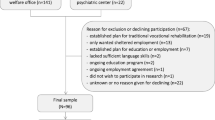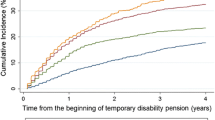Abstract
Objectives Lack of work-participation and early disability pensions (DP’s) among young adults are increasing public health problems in most western European countries. The present study investigated determinants of early DP in young adults in vocational rehabilitation. Methods Data from 928 young adults (aged 18–40 years) attending a vocational rehabilitation program was linked to DP’s recorded in the Norwegian Labor and Welfare Organization registries (1992–2010) and later compared to a group of 65 employees (workers). We used logistic regression to estimate the odds ratio for entitlement to DP following rehabilitation, adjusting for socio-demographical, psychosocial and health-behavior factors. Results Significant differences in socio-demographical, psychosocial and health-behavior factors were found between the rehabilitation group and workers. A total of 60 individuals (6.5 %) were granted a DP during follow-up. Increase in age, teenage parenthood, single status, as well as low education level and not being employed were found to be the strongest independent determinants of DP. Conclusion Poor social relations (being lone), early childbearing and weak connection to working life contributed to increase in risk of DP’s among young adults in vocational rehabilitation, also after adjusting for education level. These findings are important in the prevention of early disability retirements among young adults and should be considered in the development of targeted interventions aimed at individuals particularly at risk of not being integrated into future work lives.
Similar content being viewed by others
References
Bernitz BK, Grees N, Randers MJ, Gerner U, Bergendorff S. Young adults on disability benefits in 7 countries. Scand J Public Health. 2013;41(12 Suppl):3–26.
OECD. Mental health and work: Norway. http://www.regjeringen.no/nb/dep/asd/dok/rapporter_planer/rapporter/2013/oecd-rapport-arbeid-og-psykisk-helse.html?id=716427. OECD; 2013.
Gustafsson K, Aronsson G, Marklund S, Wikman A, Hagman M, Floderus B. Social integration, socioeconomic conditions and type of ill health preceding disability pension in young women: a Swedish population-based study. Int J Behav Med. 2014;21(1):77–87.
Ellingsen J, Lindbøl MN, Galaasen AM, Jacobsen O. Utviklingen i uførepensjon per 30. September 2013. http://www.nav.no/Om+NAV/Tall+og+analyse/Jobb+og+helse/Uf%C3%B8repensjon. The Norwegian Labour and Welfare Administration; 2013.
Hernes T, Heum I, Haavorsen P. Work Inclusion: About the new policy and practice field in welfare. Oslo: Gyldendal; 2010.
Marmot MWRG. Social determinants of health. New York: Oxford University Press; 2006.
Berkman LF, Kawachi I, Glymour MM. Social epidemiology. 2nd ed. New York: Oxford University Press; 2014.
Marmot M, Bell R. Fair society, healthy lives. Public Health. 2012;126(Suppl 1):S4–10.
Marmot MG. Understanding social inequalities in health. Perspect Biol Med. 2003;46(3):S9–23.
Gravseth HM, Bjerkedal T, Irgens LM, Aalen OO, Selmer R, Kristensen P. Life course determinants for early disability pension: a follow-up of Norwegian men and women born 1967–1976. Eur J Epidemiol. 2007;22(8):533–43.
Leinonen T, Martikainen P, Lahelma E. Interrelationships between education, occupational social class, and income as determinants of disability retirement. Scand J Public Health. 2012;40(2):157–66.
De Ridder KA, Pape K, Cuypers K, Johnsen R, Holmen TL, Westin S, et al. High school dropout and long-term sickness and disability in young adulthood: a prospective propensity score stratified cohort study (the Young-HUNT study). BMC Public Health. 2013;13:941.
Krokstad S, Westin S. Disability in society—medical and non-medical determinants for disability pension in a Norwegian total county population study. Soc Sci Med. 2004;58(10):1837–48.
Krokstad S, Johnsen R, Westin S. Social determinants of disability pension: a 10-year follow-up of 62 000 people in a Norwegian county population. Int J Epidemiol. 2002;31(6):1183–91.
Albertsen K, Lund T, Christensen KB, Kristensen TS, Villadsen E. Predictors of disability pension over a 10-year period for men and women. Scand J Public Health. 2007;35(1):78–85.
Stover M, Pape K, Johnsen R, Fleten N, Sund ER, Claussen B, et al. Unemployment and disability pension-an 18-year follow-up study of a 40-year-old population in a Norwegian county. BMC Public Health. 2012;12:148.
Ropponen A, Alexanderson K, Svedberg P. Part-time work or social benefits as predictors for disability pension: a prospective study of Swedish twins. Int J Behav Med. 2014;21(2):329–36.
Brage S, Thune O. Medisinske årsaker til uførhet i alderen 25-39 år. Oslo: The Norwegian Labour and Welfare Administration: 2009.
Mykletun A, Overland S, Dahl AA, Krokstad S, Bjerkeset O, Glozier N, et al. A Population-Based Cohort Study of the Effect of Common Mental Disorders on Disability Pension Awards. Am J Psychiatry. 2006;163(8):1412–8.
Floderus B, Hagman M, Aronsson G, Gustafsson K, Marklund S, Wikman A. Disability pension among young women in Sweden, with special emphasis on family structure: a dynamic cohort study. BMJ Open. 2012;2:e000840. doi:10.1136/bmjopen-2012-000840.
Olausson PO, Haglund B, Weitoft GR, Cnattingius S. Teenage childbearing and long-term socioeconomic consequences: a case study in Sweden. Fam Plann Perspect. 2001;33(2):70–4.
Mansson NO, Merlo J, Ostergren PO. The use of analgesics and hypnotics in relation to self-rated health and disability pension—a prospective study of middle-aged men. Scand J Public Health. 2001;29(2):133–9.
Rose G. The strategy of preventive medicine. Oxford: Oxford Unversity; 1992.
Lillefjell M, Haugan T, Martinussen P, Halvorsen T. Treatment Outcomes Among Individuals in a Musculoskeletal Pain Rehabilitation Program Related to the Prevalence and Trends in the Dispensing of Prescribed Medications. J Musculoskelet Pain. 2013;21(4):311–9.
Engel GL. The need for a new medical model: a challenge for biomedicine. Science. 1977;196(4286):129–36.
Lillefjell M, Jakobsen K. Sense of coherence as a predictor of work reentry following multidisciplinary rehabilitation for individuals with chronic musculoskeletal pain. J Occup Health Psychol. 2007;12(3):222–31.
Lillefjell M, Krokstad S, Espnes GA. Prediction of function in daily life following multidisciplinary rehabilitation for individuals with chronic musculoskeletal pain; a prospective study. BMC Musculoskelet Disord. 2007;8:65.
Akselsen A, Lien S, Siverstøl Ø. FD-Trygd, List of variables. Oslo: Statistics Norway/Department of Social Statistics/Division for Social Welfare Statistics; 2007.
Hauser R, Warren J, Haung M, Carter W. Social stratification across three generations. In: Arrow K, Bowles S, Durlauf S, editors. Meritocracy and inequality. Princeton, NJ: Princeton University Press; 2000. p. 179–229.
Zigmond AS, Snaith RP. The hospital anxiety and depression scale. Acta Psychiatr Scand. 1983;67(6):361–70.
Bjelland I, Dahl AA, Haug TT, Neckelmann D. The validity of the Hospital Anxiety and Depression Scale. An updated literature review. J Psychosom Res. 2002;52(2):69–77.
Mykletun A, Stordal E, Dahl AA. Hospital Anxiety and Depression (HAD) Scale: factor structure, item analyses and internal consistency in a large population. Br J Psychiatry. 2001;179:540–4.
Huskisson EC. Measurement of pain. Lancet. 1974;2(7889):1127–31.
McDowell I, Newell C. Measuring health—a guide to rating scales and questionaires. New York: Oxford University Press; 1997.
Chaudhary M. Seven out of ten complete secondary education. Statistic Norway; 2011. http://www.ssb.no/utdanning/artikler-og-publikasjoner/sju-av-ti-fullforer-videregaaende-opplaering.
OECD. Education at a Glance 2014. OECD indicators. OECD Publishing; 2014. doi:10.1787/eag-2014-en.
Nilsen SM, Bjorngaard JH, Ernstsen L, Krokstad S, Westin S. Education-based health inequalities in 18,000 Norwegian couples: the Nord-Trondelag Health Study (HUNT). BMC Public Health. 2012;12:998.
Caspi A, Wright BRE, Moffitt TE, Silva PA. Early failure in the labor market: childhood and adolescent predictors of unemployment in the transition to adulthood. Am Sociol Rev. 1998;63(3):424–51.
Stordal E, Bjelland I, Dahl AA, Mykletun A. Anxiety and depression in individuals with somatic health problems. The Nord-Trondelag Health Study (HUNT). Scand J Prim Health Care. 2003;21(3):136–41.
Acknowledgments
The authors would like to thank the participants of the rehabilitation programme for their permission to use personal information for research purposes. Friskgården, located in Nord-Trøndelag County, has since 1995 developed a multidisciplinary rehabilitation model for individuals at sick leave with complex disease conditions. We would also like to thank two anonymous reviewers for their helpful comments on an earlier draft of this paper.
Conflict of interest
The authors declare that they have no conflict of interest.
Informed consent
All procedures followed were in accordance with the ethical standards of the Helsinki Declaration of 1975, as revised in 2000. The study was approved by the Regional Committees for Medical and Health Research Ethics (REC) in Mid-Norway and informed consent was obtained from all participants included in the study.
Author information
Authors and Affiliations
Corresponding author
Rights and permissions
About this article
Cite this article
Myhr, A., Haugan, T., Espnes, G.A. et al. Disability Pensions Among Young Adults in Vocational Rehabilitation. J Occup Rehabil 26, 95–102 (2016). https://doi.org/10.1007/s10926-015-9590-5
Published:
Issue Date:
DOI: https://doi.org/10.1007/s10926-015-9590-5




